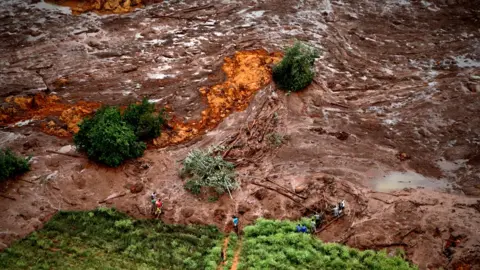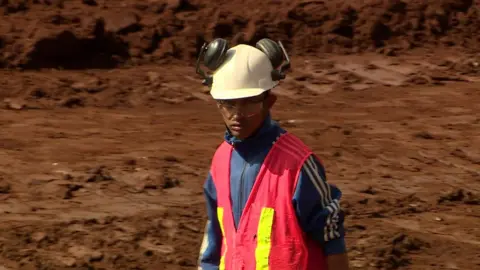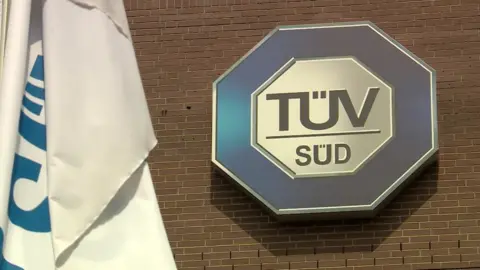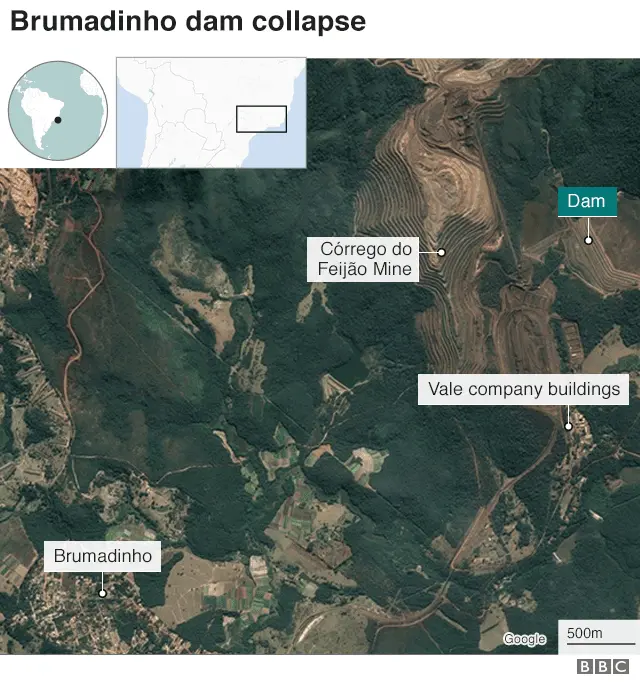Brazil dam: How German firm approved Brazil dam before it burst
Six months after a deadly dam collapse in Brazil, new evidence has emerged that suggests the disaster could have been prevented.
Investigators believe there's evidence the German company that certified the structure as safe knew it was vulnerable to collapse.
Nearly 300 people died when the collapse triggered a mudslide near the south-eastern town of Brumadinho.
A prosecutor and lawmaker say German firm Tüv Süd is failing to co-operate.
They complain the company's lack of co-operation is affecting their inquiries.
The BBC has seen emails that show Tüv Süd's own analysis of the dam initially failed to meet official requirements.
The company declined an interview.
How the tragedy unfolded
The dam at Brumadinho collapsed in a matter of seconds on 25 January. A torrent of toxic sludge rushed down the valley, engulfing everything and everyone in its path.
There was no warning. Sirens designed to warn of such a scenario didn't go off.
 EPA
EPADownstream, workers who had just sat down to lunch in the mine's canteen, would have had little chance to escape.
Victims still being found
At his home, in the hills above the mine, Aramaio describes how his sister, a dinner lady, was serving food in the canteen when it was destroyed by the mudslide.
Her remains have never been found. His sister-in-law was also killed.

"We are devastated," he says. "We feel destroyed."
The clear-up is still going on and even now they're finding bodies here.

Prosecutors have many questions for the mine's owner, Vale, but they have also focused on the role of the German company that inspected the dam in the months before the collapse.
The German company with an international name
Tüv Süd is a household name in Germany and a byword for safety.
The inspection company was founded well over a century ago, offering safety checks on steam engines.
Step into a lift these days and you're likely to see its distinctive blue and white logo. It inspects and certifies all manner of goods and services - including annual vehicle tests.
And it has exported its reputation internationally, carrying out inspections all over the world.

In 2013 it acquired an engineering consultancy company, based in São Paolo, called Bureau de Projetos. This was Tüv Süd's chance to gain a foothold in the lucrative Brazilian mining industry and the firm picked up a number of contracts with Vale, one of the world's biggest mining companies.
Tüv Süd's website describes itself as "a community of experts united by the belief that technology should better people's lives".
What is the evidence?
The structure that collapsed was a "tailings" dam. For decades, waste product from the mine had been piled up and grassed over.
Put simply, unlike conventional dams, there is no extra wall or barrier; the solid waste holds itself in place. Tailings dams are vulnerable to "liquefaction", when, for various reasons, the solid material begins to act and move like a liquid, putting them at risk of becoming vulnerable to collapse.
Documents and internal emails seized by investigators show that Tüv Süd employees knew for around a year that there was liquefaction at the dam.
The company had contracts worth €4m (£3.6m; $4.5m) with Vale at and around the site, including one, signed in December 2017, to assess and suggest solutions for liquefaction at the dam. One such solution is known to have failed in June 2018.
In the following months email exchanges show that Tüv Süd's analyses of the dam failed to meet the official safety level required to certify the dam.


Investigators have now established that they eventually "solved" this problem by changing the way in which the dam was certified.
They attached conditions of use to the certification: making it, for example, dependent on there being no explosions around the site - unlikely in mining country. This enabled them to sign it off despite its weakness.

Internal emails between Tüv Süd staff in Brazil (translated from Portuguese)
13 May 2018: "We're finishing the studies about liquefaction of the dam B1, but everything points that it won't pass."
15 May 2018: "The results and figures leave us in a very vulnerable position."
9 November 2018: "This dam has a liquefaction problem."
Two days after the mine collapsed, in an exchange with managers, Tüv Süd employees acknowledge that they have also certified the stability of three other dams.
One seeks to reassure his boss. "Don't worry. All three dams were affected by the collapse of B1", intimating that the work cannot now be checked.
12 March 2019: Tüv Süd wrote to mine-owner Vale.
"Our experts are not able to confirm the stability of any of the dams mentioned in these proceedings (lists 9 dams)… optimistic choices of parameters were used on those calculations."

Read more on the dam collapse:

The unanswered questions
What we don't know is why.
Was Tüv Süd under pressure from Vale?
There's some evidence that inspectors were concerned at what might happen to Tüv Süd's contracts if they didn't certify the dam. Two other companies had refused to sign it off and been dismissed.
It's also unclear how far up Tüv Süd's management chain decisions were made.
Some email exchanges reveal that local employees intended to communicate what was happening to at least one boss who was based in Germany.

'Lack of co-operation'
The state prosecutor responsible for criminal charges, William Garcia Pinto Coelho, told the BBC that Tüv Süd "as a corporation is choosing to stay silent".
"I have no doubt that a more collaborative approach might bring new light to the case and also clarify what happened behind closed doors."
And, we were told, Tüv Süd had failed to co-operate with an inquiry by the Brazilian parliament.
It is one of two such inquiries. A senate investigation recently recommended that 14 individuals, most from Vale and two from Tüv Süd, be indicted though it did not identify them by name.
Congresswoman Aurea Carolina said that the only senior Tüv Süd employee to give evidence was the head of compliance for Tüv Süd Brazil who had never visited Brumadinho and was unable to answer any important questions.
"In a criminal process it's natural the accused don't want to explain everything," she told the BBC.
"But this is a disaster of great magnitude with a shockingly high number of victims. It's unprecedented in Brazil. This should involve our international relations with Germany because Tüv Süd's headquarters are based there."
What the companies say
Tüv Süd declined the BBC's request for an interview but said they were working intensively towards establishing what happened.
Vale says that regular internal and external audits were carried out at the site and that no anomalies were detected that implied an imminent risk of rupture.
The German government told the BBC that, while it expected every German company in cases like this to co-operate to the best of their ability, it ultimately had no responsibility in this instance.
For a short time, disaster drew the eyes of the world to Brazil's mining region.
Those who survived fear that they won't look back, leaving their questions unanswered and their dead forgotten.
